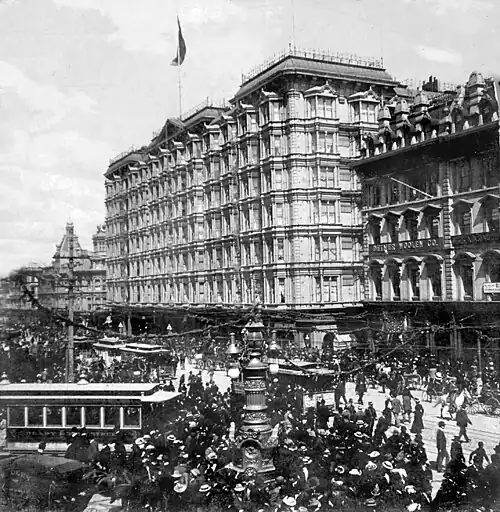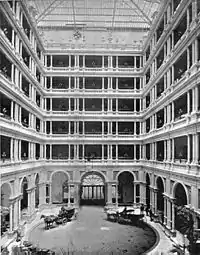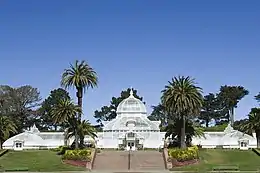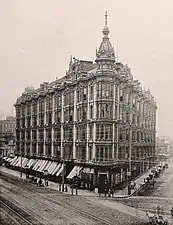John Plant Gaynor | |
|---|---|
| Born | circa 1826 |
| Died | June 9, 1888 |
| Nationality | Irish American |
| Occupation | Architect |
| Buildings | E. V. Haughwout Building; Palace Hotel |

John P. Gaynor (circa 1826–1888) was an Irish American architect practicing in New York City and San Francisco during the nineteenth century.
Life and career
John Plant Gaynor was born circa 1826 in Dublin, Ireland. He was the son of surveyor John P. Gaynor, and likely received his early architectural training in the architectural school of the Royal Dublin Society.[1] In 1849 he immigrated to the United States, and practiced architecture in Brooklyn and New York beginning in 1851. There he was best known for the design of the E. V. Haughwout Building, a cast-iron fronted building completed in 1857. In 1863 he relocated to San Francisco, where he designed several large hotels and office buildings, most prominently the original Palace Hotel, completed in 1875 and destroyed in 1906.[2] His clients included the financiers William C. Ralston and Asbury Harpending. Gaynor retired in the mid-1880s and retired to his home in Oakland, where he died June 9, 1888.[3]
Legacy
Gaynor frequently utilized cast-iron elements in his architecture, both in New York and San Francisco. His E. V. Haughwout Building in New York City, completed in 1857, was thought by preservationist Margot Gayle to be "The most celebrated of the cast-iron buildings still standing in New York City." He also designed the first cast-iron buildings in San Francisco.[4] Though much of his work has been destroyed, several of his remaining buildings have been listed on the United States National Register of Historic Places.
Architectural works
- Halsey (Arbuckle) Building, 367 Fulton St, Brooklyn, New York (1856, demolished)[2]
- E. V. Haughwout Building, 488-492 Broadway, New York, New York (1856–57, NRHP 1973, NYCL 1965)[2]
- "Belmont" for William C. Ralston, Belmont, California (1865–68, NRHP 1966)[5]
- Oriental Block, Market and Battery Sts, San Francisco, California (1867, demolished)[6]
- Harpending Block, Market St, San Francisco, California (1869, burned and rebuilt 1871, destroyed 1906)[7][3]
- Grand Hotel, Market and New Montgomery Sts, San Francisco, California (1870, destroyed 1906)
- Palace Hotel, 2 New Montgomery St, San Francisco, California (1873–75, destroyed 1906)[2]
- Savings and Loan Society Building, Clay St, San Francisco, California (1873–74, destroyed 1906)[2]
- Conservatory of Flowers,[lower-alpha 1] Golden Gate Park, San Francisco, California (1878, NRHP 1971)[5]
- Phelan Building, 760 Market St, San Francisco, California (1881, destroyed 1906)[8]
- Sharon Row, 1400-1412 Golden Gate Ave, San Francisco, California (1884)[5]
Gallery of architectural works
 E. V. Haughwout Building, New York, New York, 1856-57.
E. V. Haughwout Building, New York, New York, 1856-57. Belmont, Belmont, California, 1865-68.
Belmont, Belmont, California, 1865-68. Palace Hotel, San Francisco, California, 1873-75.
Palace Hotel, San Francisco, California, 1873-75. Grand Court of the Palace Hotel, San Francisco, California, 1873-75.
Grand Court of the Palace Hotel, San Francisco, California, 1873-75. Savings and Loan Society Building, San Francisco, California, 1873-74.
Savings and Loan Society Building, San Francisco, California, 1873-74.

Notes
- ↑ Built with material bought from Lord & Burnham, greenhouse manufacturers, and originally intended to be built on James Lick's estate in Santa Clara.
References
- ↑ Gaynor, John Plant, Dictionary of Irish Architects 1720-1940.
- 1 2 3 4 5 Margot Gayle, "Gaynor, John P." in Macmillan Encyclopedia of Architects, vol. 2, ed Adolf K. Placzek (New York: Free Press, 1982): 181.
- 1 2 "John P. Gaynor's Death" in Daily Alta California, June 10, 1888.
- ↑ Margot Gayle and Edmund V. Gillon Jr., Cast-Iron Architecture in New York: A Photographic Survey (New York: Dover Publications, 1974)
- 1 2 3 Susan Dinkelspiel Cerny, An Architectural Guidebook to San Francisco and the Bay Area (Salt Lake City: Gibbs Smith, 2007)
- ↑ "Oriental Block" in Daily Alta California, January 15, 1868.
- ↑ "Local Intelligence" in Daily Alta California, March 30, 1869.
- ↑ Pen Pictures from the Garden of the World, or, Santa Clara County, California, Illustrated, ed. H. S. Foote (Chicago: Lewis Publishing Company, 1888)